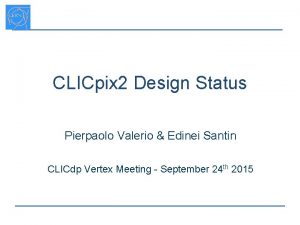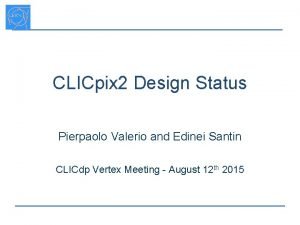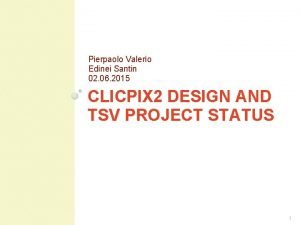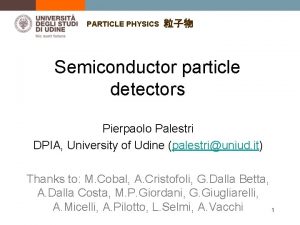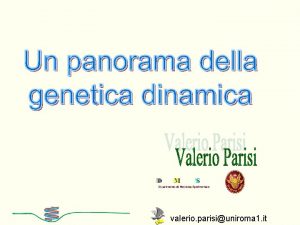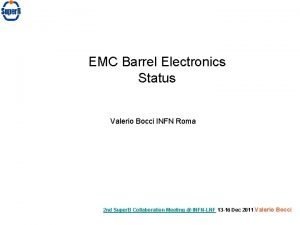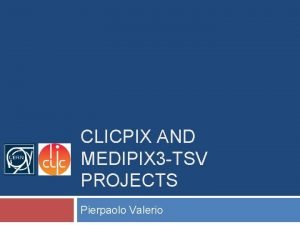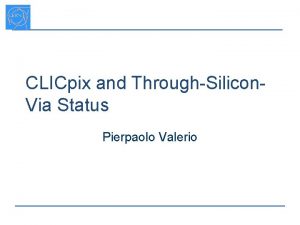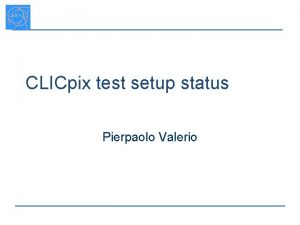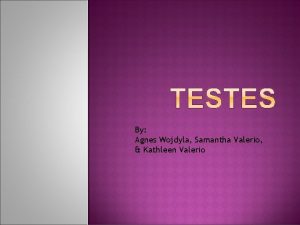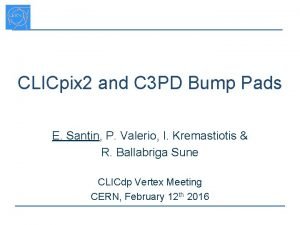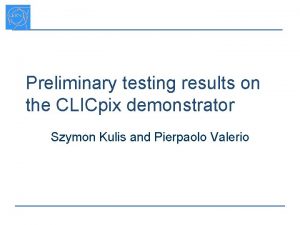Pierpaolo Valerio DESIGN CONSIDERATIONS FOR CLICPIX 2 AND















- Slides: 15

Pierpaolo Valerio DESIGN CONSIDERATIONS FOR CLICPIX 2 AND STATUS REPORT ON THE TSV PROJECT 1

CLICpix is a hybrid pixel detector to be used as the CLIC vertex detector � Main features: � ◦ Simultaneous TOA and TOT measurements ◦ Power pulsing ◦ Data compression � 3 mm ◦ small pixel pitch (25 μm), A demonstrator of the CLICpix architecture with an array of 64 x 64 pixels has been submitted and tested 1. 85 mm 2

Current results � Latest results on CLICpix were presented by Daniel Hynds before � The chip works well and it provides a good proofof-concept for a CLIC vertex detector built with current technology � CLICpix has been tested in a test-beam scenario using an HV-CMOS sensor. Tests with a Si sensor are planned for the future 3

Issues with the current chip � However, the current chip has a few issues… � Charge injection from discriminator output to the input pad. ◦ This is the most serious issue. It changes the minimum threshold significantly and creates a difference between left/right pixels in a double column and between positive/negative polarity D. Hynds 4

Other issues Other smaller issues are also present: � Charge injection from digital side � ◦ This issue is more limited and it causes increased noise for a certain range of clock frequencies. � Compression bug ◦ Very simple logic bug that slows down the readout when using cluster/column compression 5

Design limitations �Small counters ◦ 4 bits TOA is not enough (even for a CLIC application) �We require a 10 ns accuracy over a 160 ns period, so we need 5 bits to accommodate for chip-to-chip timing calibration ◦ 4 bits TOT is enough, but a longer counter would allow more accurate measurements ◦ 4 bits event counter results in really long and tedious testing routines �Small matrix (64 by 64 pixels) ◦ Small area increases the time it takes to get statistics �“Clunky” readout ◦ A few interface design choices resulted in a more complicated test setup than what was foreseen 6

CLICpix 2: Architecture improvements �Larger Counters ◦ 6 bits TOT for more accurate energy measurements ◦ 8 bits TOA should be possible – a total of 14 bits is most probably achievable, but it needs to be validated ◦ A new mode of operation with a single 14 bits counter for To. A / Event Counting �Larger matrix (128 by 128) �More convenient readout ◦ 8/10 bit encoding for high speed readout �A few more IP blocks can be used (and tested), such as a band-gap 7

Bug fixing � Implement a better shielding to avoid noise injection and achieve a lower minimum threshold � Fix small bug in the readout logic � Increase comparator gain to be less sensitive to cross-talk from the digital pixels � Improve the test-pulse mechanism to have easier and more accurate testing routines M 4 Discriminator 2 nd stage output M 6/M 7 Preamplifier input 8

Project status �The analog part of the pixel was updated and re-simulated successfully ◦ This part needs to be laid out again from scratch to merge structures among adjacent pixels and to reduce cross-talk �The digital pixel part was modified and fixed. However, a more robust testbench for the digital side is required to avoid bugs �IP blocks need to be integrated �Periphery blocks must be updated to correctly manage the larger pixel matrix 9

The Medipix TSV project Objectives : » Fabrication of a read-out chip with Through-Silicon Vias (TSV) » Assembly of a particle detector on top of it J. Alozy 10

TSV second run � Launched in CEA LETI (Grenoble) in March 2014 and delivered to CERN in October 2014 ◦ The main motivation of the second run was to obtain good yields in order to validate the TSV process applied on Medipix chips � Lot # μSA 999 P of 3 wafers: ◦ P 04 (W 128 -AZPGBPH) : completed, delivered to CERN and tested ◦ 14 chips (7 class AA + 7 with other classes) sent to ADVACAM for assembly First assemblies recently received. Test in progress. ◦ P 05 (W 127 -AKPGALH) : need rework (during 3 D 06) ◦ P 06 (W 126 -AMPG 6 LH) : completed, delivered to CERN and tested � Lot # μSB 254 P of 3 wafers ◦ P 01 (W 125 A 3 PGC 2 H) : completed, delivered to CERN and tested ◦ P 02 (W 124 ACPGAUH) : completed, delivered to CERN and tested ◦ P 03 (W 123 A 0 PGBNH) : completed, delivered to CERN and 11

TSV second run After foundry production and TSV added process the final yield is 45% of fully functional chips * Original wafer probing results (Foundry yield) We obtained very encouraging results and we have enough good chips to validate the process Lot # μSA 999 P Perfect chips before TSV Perfect chips after TSV Lot # μSB 254 P P 04 P 05 P 06 P 01 P 02 P 03 57% 51% 50% 60% 53% 45% 41% In rework 20% 41% 38% 12

TSV third run �LOT 1: stopped with TSV-last seed deposition due to presence of residues in via bottom ◦ estimated delivery date: moved from mid November 14 to February 2015 �LOT 2: at TSV etching, stopped until polymer issue is solved ◦ LOT 2 estimated delivery date: moved from end of December 14 to march 2015 13

TSV third run � Some arcing effects at wafer edge were observed after hard mask etching ◦ Arcing issue is a well know problem with silicon on “spin on glass” wafers due to capacitive effect of substrate on electrostatic chuck ◦ Problem has been fixed on 120 µm thick wafers (no issue on last run) With 50 µm wafers the capacitance increases and makes the process more sensitive � The issues are more important because of the presence of defects at the edge of the wafer : glue or lithography resin residues. No arcing on Si test wafers � These defects are limited to the very edges of the wafer an good dies should not be affected � � Polymer residues were observed at TSV bottom after RDL lithography step of LOT#1. It has been decided to stop the process to try to remove the residues and investigate how to avoid this effect on LOT#2 14

THANKS FOR YOUR ATTENTION Your input for CLICpix 2 is welcome!! 15
 Pierpaolo valerio
Pierpaolo valerio Pierpaolo valerio
Pierpaolo valerio Pierpaolo valerio
Pierpaolo valerio Particle detector
Particle detector Quasi experimental design ethical issues
Quasi experimental design ethical issues Durite
Durite Database design considerations
Database design considerations Collaboration design considerations
Collaboration design considerations Biopharmaceutic considerations in drug product design
Biopharmaceutic considerations in drug product design Design considerations icons
Design considerations icons Design considerations for mobile computing
Design considerations for mobile computing Practical considerations for costume design might include
Practical considerations for costume design might include Valerio parisi genetica ed evoluzione
Valerio parisi genetica ed evoluzione Kellee valerio
Kellee valerio Valerio bocci
Valerio bocci Valerio andreozzi
Valerio andreozzi
